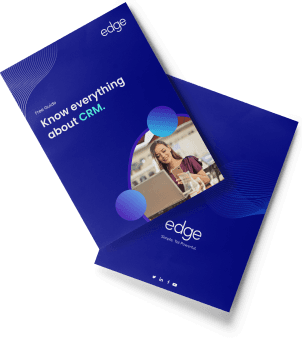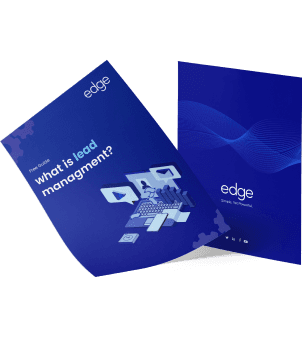Introduction
Whether you're new to sales or an experienced professional looking to advance, this guide on sales prospecting is a must-read.
Prospects, potential customers you want to sell to, are the lifeblood of your sales pipeline. Each prospect represents a possible opportunity for a deal, so expanding your prospect base and nurturing them will directly contribute to growing your revenue.
While prospecting is crucial, it can sometimes feel like you rely on luck for the right people to come your way.
In this guide, we'll cover the following topics what is sales prospecting, what is the importance of it & different techniques of prospecting.
Let's dive in and discover the secrets to successful prospecting!
What is sales prospecting?
Sales prospecting is the initial step in the sales cycle, where you actively search for potential customers who fit your target market. It involves researching, identifying, and reaching out to individuals or companies who may have an interest in your product or service. The goal is to initiate a conversation and generate interest, ultimately leading to a sales opportunity.
Importance of Sales Prospecting
Sales prospecting plays a crucial role in the success of any sales team or business. Here are a few key reasons why it is important:
1. Generating a consistent pipeline:
Prospecting ensures a steady stream of potential customers, maintaining a healthy pool of prospects for conversion.
2. Targeting the right audience:
Effective prospecting focuses efforts on individuals or companies most likely interested in your product/service, increasing chances of connecting with qualified leads.
3. Building relationships:
Prospecting is about building relationships with potential customers, establishing trust, and positioning yourself as a valuable resource for long-term partnerships.
4. Maximizing sales opportunities:
Effective prospecting uncovers potential customers and maximizes sales opportunities, preventing missed chances for valuable client acquisition.
Methods of sales prospecting
1. Cold Calling
Cold calling involves reaching out to potential customers or leads without prior interaction with your business. It can be done through phone calls, emails, or social media messages.
The goal is to introduce your product or service, generate interest, and schedule a meeting or sales conversation. Cold calling is effective for proactively engaging with prospects and connecting personally.
Presenting a compelling value proposition and addressing their needs can lead to successful conversions.
Tips and best practices for successful cold calling:
1. Research prospects:
Gather information to customize your approach and show understanding.
2. Craft a compelling opening statement:
Grab attention with a concise introduction highlighting your value.
3. Personalize your approach:
Customize your message, mentioning their company or common connections to establish relevance.
4. Listen actively:
Pay attention, show genuine interest, and ask thoughtful questions to uncover their needs.
2. Email Marketing
Ready to supercharge your sales game?
Email marketing is the secret weapon that lets you connect directly with potential
customers with a personal touch that speaks to their needs and desires.
Here's why email marketing is your ticket to prospecting success:
Direct communication: Tailor your messages to individual prospects, addressing their needs and pain points head-on.
Scaling new heights: Reach many prospects simultaneously, expanding your reach and engaging potential customers efficiently.
Cost-effective and measurable wins: Bid farewell to high marketing costs. Email marketing is budget-friendly and offers precise metrics to measure your success.
Effective email prospecting strategies:
1. Personalized Messaging Mastery:
Craft emails that speak directly to each recipient, mentioning their name and pain points to demonstrate your dedication to solving their problems.
2. Subject Lines that Sizzle:
Stand out in crowded inboxes with attention-grabbing subject lines. Experiment with concise, catchy, customized subject lines to pique curiosity and entice prospects to click.
3. Crystal-Clear Content:
Keep your emails focused and easily digestible. Communicate how your product or service can be the solution. Utilize bullet points, subheadings, and paragraphs for clarity.
Building Targeted Lists and Measuring Your Triumphs:
4. Bullseye Targeting:
Create email lists that precisely target your ideal audience. Segment prospects based on industry, job title, or location, capturing email addresses through various channels.
5. Measure Your Might:
Track the success of your email campaigns like a pro. Monitor open rates, click-through rates, and conversions. Analyze responses, follow-ups, and sales generated from your emails.
Now armed with these email marketing strategies, you're ready to conquer the sales prospecting world.
Unleash your creativity, captivate your prospects, and watch your engagement and conversion rates soar.
3. Social Media Prospecting
Social media platforms have become treasure troves for better sales. Each platform offers unique opportunities to connect with potential customers and turn them into valuable leads.
Let's uncover the world of social media prospecting and discover the potential of platforms like LinkedIn, Twitter, and Facebook:
I. LinkedIn:
Known as the professional networking hub, LinkedIn is a goldmine for B2B sales.
To identify prospects, utilize LinkedIn's advanced search filters to narrow your target audience based on industry, job title, location, and more.
II. Twitter:
With its fast-paced and real-time nature, Twitter is perfect for engaging with prospects and building brand visibility.
Leverage hashtags and industry-specific keywords to find prospects actively discussing relevant topics.
III. Facebook:
Although primarily a social platform, Facebook offers opportunities for generating good sales, especially in B2C markets.
Start by creating a Facebook business page and building a community around your brand.
Join relevant groups and communities where your target audience resides. Share engaging content, run targeted ads, and promptly respond to comments and messages.
Now, let's equip you with some essential tips to create an effective social media prospecting strategy:
1. Start by defining your goals on social media.
Clearly outline your objectives on social media, whether lead generation, brand awareness, or thought leadership. This clarity will guide your strategy.
2. Get to know your target audience like never before.
Dive deep into demographics, interests, pain points, and preferred social media platforms. Craft messages and strategies tailored to their preferences.
3. Consistency is the secret sauce for successful branding.
Maintain a unified visual aesthetic, captivating copy, and a distinctive brand voice. Stand out amidst the digital noise and ensure recognition and recall.
4. Value, value, and more value!
Your prospects crave it. Focus on delivering educational content, industry insights, and practical solutions. Become the trusted advisor your prospects turn to for guidance and expertise.
5. Engage, interact, and nurture.
Actively engage by commenting, liking, and sharing prospects' content. Respond promptly to messages and inquiries, showcasing genuine care. Nurture relationships with personalized recommendations and ongoing support.
4. Content Marketing
Content marketing is a game-changer for sales prospecting. By creating valuable and informative content, businesses can attract prospects, build trust, and position themselves as industry leaders.
Here's how it works:
I. Valuable content:
Create high-quality, educational content that addresses pain points and establishes you as a trusted source, capturing prospects' attention and engagement.
II. Optimized for lead generation:
Embed
lead capture forms, calls-to-action, and enticing offers to gather information and guide prospects through the sales funnel.
III. Nurturing prospects:
Keep leads engaged with tailored content, email campaigns, and personalized recommendations that address their needs, guiding them toward purchasing.
By harnessing the power of content marketing, you can attract prospects, earn their trust, and guide them toward becoming loyal customers.
5. Networking and Referrals
Networking and referrals allow you to reach a wide range of potential customers. Here's how to maximize their power:
I. Networking:
Attend events, join professional groups, and connect with colleagues to establish valuable relationships that can lead to referrals and collaborations.
II. Referrals:
Referrals are highly valuable in prospecting. They bring trust and credibility, making engaging and converting prospects into customers easier.
Tips for Building and Maintaining Networks:
I. Be Proactive:
Seek networking opportunities, show genuine interest, ask thoughtful questions, and actively listen to build meaningful connections.
II. Utilize Online Platforms:
Leverage LinkedIn and other professional platforms to expand your network, connect with industry professionals, and join relevant groups.
III. Maintain Relationships:
Stay in touch by sending personalized messages, sharing relevant content, and offering support. Genuine engagement strengthens your network.
IV. Provide Exceptional Service:
Delight existing customers to encourage them to refer you to others.
V. Ask for Referrals:
Don't hesitate to request referrals from satisfied customers, colleagues, or partners.
VI. Offer Incentives:
Implement referral programs or provide rewards to motivate people to refer prospects actively.
6. Sales Events and Conferences
Industry events and conferences are game-changers for sales prospecting. They bring together professionals from your target market, creating a prime opportunity to connect, build relationships, and discover potential customers.
Here's why they can skyrocket your prospecting efforts:
Networking Goldmine: Industry events offer a wealth of networking opportunities, connecting you with like-minded individuals, experts, and potential prospects, establishing valuable connections and paving the way for future business opportunities.
Lead Capture Galore: Events provide a concentrated pool of leads. Utilize techniques like badge scanning, business card collection, or event-specific apps for efficient contact gathering, ensuring effective follow-up with prospects after the event.
Effective Techniques for Event Success:
Research the event beforehand, understand your target audience, and set goals to optimize your time and identify valuable connections.
Engage with attendees, speakers, and exhibitors by starting conversations, asking insightful questions, and sharing your expertise to build meaningful connections.
After the event, promptly follow up with prospects, personalize messages, reference the event, and continue the conversation. Offer additional value through relevant resources or insights to nurture the relationship.
7. Webinars and Online Events
Webinars offer a unique platform for businesses to demonstrate their expertise and connect with a targeted audience. By hosting webinars, you can showcase your industry knowledge, address pain points, and provide valuable solutions.
Benefits of Hosting Webinars and Engaging with Attendees:
I. Establishing Authority:
Webinars showcase expertise, build attendees' trust and credibility, and position your business as a trusted advisor.
II. Lead Generation:
Webinars collect participant information for follow-up and lead nurturing, engaging potential customers and guiding them through the sales funnel.
III. Audience Insights:
Webinars offer valuable insights into your target audience's pain points, preferences, and interests, informing future sales and marketing strategies.
To maximize the effectiveness of webinars for better sales, consider the following tips:
Promote your webinar through various channels, including social media, email marketing, and your website.
Develop a captivating and informative webinar presentation that addresses common challenges your audience faces.
After the webinar, nurture your leads by providing additional resources, such as whitepapers, case studies, or exclusive offers.
Utilize analytics tools to measure the success of your webinar, including attendance rates, engagement levels, and lead conversions.
8. Direct Mail Campaigns
Direct mail may seem like a relic of the past. However, it remains a valuable and effective tool.
Its tangible impact, personalization capabilities, trust-building potential, lower competition, and compatibility with other marketing channels make it a valuable addition to any comprehensive prospecting strategy.
The Role of Direct Mail in a Digital Age:
Direct mail offers a tangible and personal touch that digital marketing often lacks. It can grab attention and create a lasting impression. Integrating direct mail into your strategy allows you to stand out in a crowded digital landscape and uniquely engage with potential customers.
Creative and Personalized Direct Mail Campaigns:
To make your direct mail campaigns effective, creativity and personalization are key. Consider using personalized messages, custom packaging, or incorporating interactive elements like QR codes or augmented reality.
Tracking and Measuring Effectiveness:
Tracking and measuring the effectiveness of direct mail efforts is essential for optimizing your sales prospecting strategy. Use unique tracking codes or personalized URLs to attribute responses to specific mail pieces. Utilize customer feedback and response rates to refine your campaigns and improve future prospecting efforts.
You can capture attention and engage with potential customers by leveraging its tangible and personal nature.
9. Customer Referrals
Customer referrals tap into the trust and influence of satisfied customers to generate new leads. Customer referrals are a powerful tool for generating new leads. They harness the trust and influence of satisfied customers to expand your customer base.
The Power of Customer Referrals:
Customer referrals carry significant weight because they come from trusted sources. When a satisfied customer refers your business to their network, it adds credibility and social proof. Referrals have a higher chance of converting into leads because they already have a positive impression of your brand.
Strategies for Encouraging and Incentivizing Referrals:
I. Ask satisfied customers for referrals and make it easy for them to share their experiences.
II. Offer incentives such as discounts, loyalty rewards, or exclusive access to products or services for successful referrals.
III. Many companies have successfully used customer referrals for sales prospecting. For example, Dropbox grew rapidly by offering additional storage space for customers who referred friends.
V. Airbnb also leveraged referrals by providing travel credits to referrers and new customers. These success stories demonstrate the immense potential of customer referrals in expanding customer networks and driving sales growth.
V. Businesses can encourage customers to actively refer to their network by implementing effective strategies and incentives. Embracing the power of customer referrals can lead to significant business growth and success.
10. Sales Prospecting Software and Tools
Utilizing the right software and tools in marketing can significantly enhance efficiency, productivity, and success. Sales prospecting software and tools are crucial in streamlining and enhancing prospecting efforts. They offer valuable features that boost productivity and enable sales teams to engage effectively with prospects.
Importance of Sales Prospecting Tools:
Sales prospecting tools automate tasks, save time, and offer features like lead generation, contact management, email automation, and analytics.
Popular Tools and Features:
HubSpot Sales, Salesforce, Pipedrive, and LinkedIn Sales Navigator are popular tools with features like lead capture, email tracking, data enrichment, social selling insights, and sales pipeline development.
Selecting the Right Tools:
Consider needs, budget, team size, target audience, desired features, and integration capabilities. Prioritize user-friendly tools aligned with your strategy and supported by positive reviews.
By carefully selecting tools that align with specific needs and goals, sales professionals can optimize their prospecting processes and drive better results.
11. LinkedIn Sales Navigator
LinkedIn Sales Navigator is a powerful tool for sales professionals to identify, connect, and engage potential prospects. Its features, such as advanced search filters and real-time insights, offer valuable advantages in sales prospecting.
Features and Benefits of LinkedIn Sales Navigator:
Advanced search filters, lead recommendations, real-time insights, saved leads, and InMail messaging empower sales professionals. This tool provides access to a vast professional network, enabling sales professionals to identify decision-makers and build relationships based on accurate data and valuable insights.
I. Leveraging LinkedIn's Platform:
Optimize your profile, use advanced search filters, and engage with valuable content, groups, and personalized connection requests.
II. Maximizing LinkedIn Sales Navigator:
Save leads, leverage real-time insights, personalize InMail messages, and integrate with CRM systems for efficient prospecting.
12. Cold Email Outreach
Cold email outreach is a powerful technique that allows you to reach out to potential customers who haven't engaged with your business before.
It is an effective method that enables you to reach potential customers who haven't yet engaged with your business.
I. Understanding Cold Email Outreach:
Cold email outreach involves sending targeted emails to prospects without prior contact with your business.
It is an opportunity to introduce yourself, highlight your value, and initiate a conversation that can lead to sales opportunities.
II. Crafting Compelling Cold Emails:
Focus on intriguing subject lines, concise messages addressing pain points, personalized language, and relevant details to showcase understanding and credibility.
III. Personalization, Follow-ups, and Tracking:
Personalize emails based on prospect research, strategically followed up with reminders and added value, and track metrics like open rates and responses to optimize your cold email campaigns.
13. Sales Prospecting Metrics and Analytics
Tracking and measuring prospecting efforts is vital for sales success. It empowers sales teams to make data-driven decisions and optimize their strategies.
Importance of Tracking and Measuring:
Tracking and measuring prospecting efforts provide insights to optimize resource allocation and improve efficiency.
Key Metrics for Evaluation:
Evaluate conversion rates, response rates, lead quality, revenue generated, open email rates, click-through rates, and engagement metrics to gauge prospect engagement and effectiveness.
Refining and Optimizing with Data:
Analyze data to identify patterns, trends, and areas for improvement. Refine target audience, messaging, and sales outreach strategies based on insights to maximize results.
Conclusion
Sales prospecting is a vital process that enables businesses to connect with their target audience, establish relationships, and secure deals.
This blog discussed many sales prospecting strategies like cold calling, email outreach, social media engagement, and networking to reach potential customers.
It is essential to have a solid understanding of the target market, utilize effective communication and persuasion techniques, and leverage technology and data to optimize prospecting efforts.
By implementing a strategic and consistent approach to sales prospecting, businesses can maximize their opportunities for growth and drive sustainable business success.




























